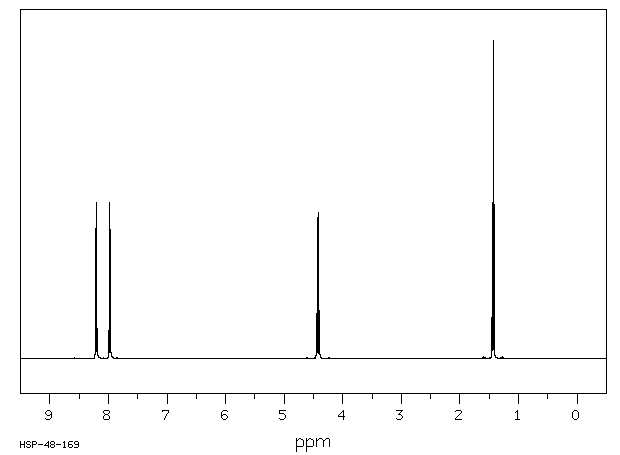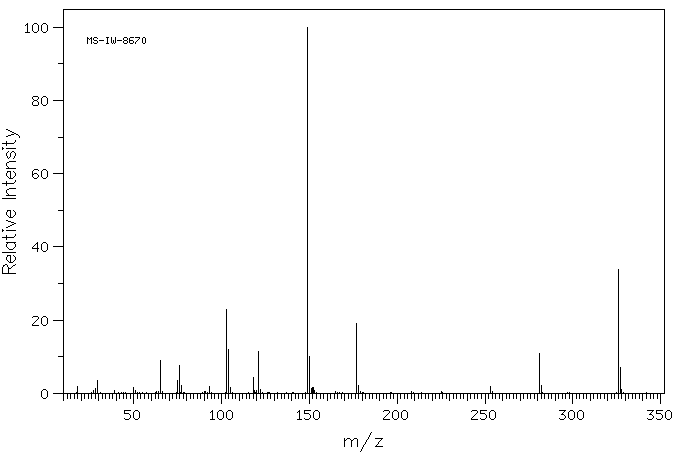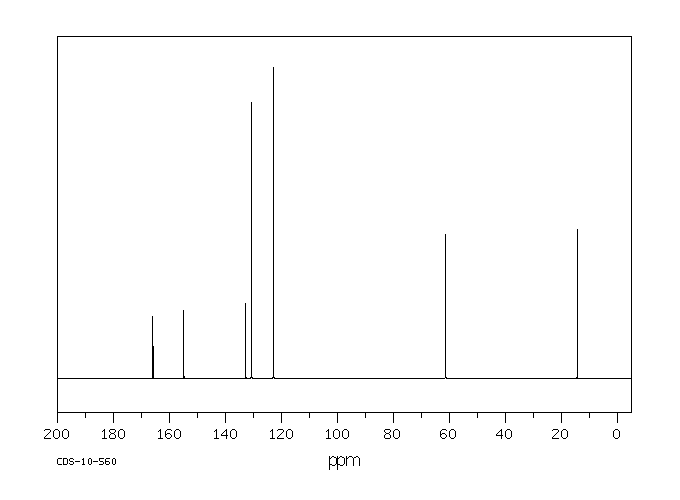偶氮苯-4,4’-二羧酸二乙酯 | 7250-68-2
中文名称
偶氮苯-4,4’-二羧酸二乙酯
中文别名
4,4'-偶氮二苯甲酸二乙酯;偶氮苯-4,4'-二羧酸二乙酯;偶氮苯-4,4-二羧酸二乙酯;二乙基4,4'-偶氮二苯甲酸酯;二乙基偶氮苯-4,4'-二羧酸酯
英文名称
4,4'-bis(ethoxycarbonyl)azobenzene
英文别名
diethyl 4,4'-(diazene-1,2-diyl)dibenzoate;azobenzene-4,4'-dicarboxylic acid diethyl ester;Diethyl 4,4'-Azodibenzoate;ethyl 4-[(4-ethoxycarbonylphenyl)diazenyl]benzoate
CAS
7250-68-2
化学式
C18H18N2O4
mdl
——
分子量
326.352
InChiKey
YFFNOBALALSBCH-UHFFFAOYSA-N
BEILSTEIN
——
EINECS
——
-
物化性质
-
计算性质
-
ADMET
-
安全信息
-
SDS
-
制备方法与用途
-
上下游信息
-
文献信息
-
表征谱图
-
同类化合物
-
相关功能分类
-
相关结构分类
物化性质
-
熔点:144 °C
-
沸点:472.3±30.0 °C(Predicted)
-
密度:1.16±0.1 g/cm3(Predicted)
计算性质
-
辛醇/水分配系数(LogP):4.1
-
重原子数:24
-
可旋转键数:8
-
环数:2.0
-
sp3杂化的碳原子比例:0.22
-
拓扑面积:77.3
-
氢给体数:0
-
氢受体数:6
安全信息
-
海关编码:2927000090
-
危险性防范说明:P261,P280,P301+P312,P302+P352,P305+P351+P338
-
危险性描述:H302,H315,H319,H335
-
储存条件:室温
SDS
Diethyl 4,4'-Azodibenzoate
SAFETY DATA SHEET
Section 1. IDENTIFICATION OF THE SUBSTANCE OR MIXTURE AND OF THE SUPPLIER
Product name: Diethyl 4,4'-Azodibenzoate
Section 2. HAZARDS IDENTIFICATION
Classification of the GHS
PHYSICAL HAZARDS Not classified
HEALTH HAZARDS Not classified
Not classified
ENVIRONMENTAL HAZARDS
GHS label elements
None
Pictograms or hazard symbols
Signal word No signal word
None
Hazard statement
Precautionary statements None
Section 3. COMPOSITION/INFORMATION ON INGREDIENTS
Substance/mixture: Substance
Component(s): Diethyl 4,4'-Azodibenzoate
Percent: >95.0%(GC)
CAS Number: 7250-68-2
Synonyms: 4,4'-Azodibenzoic Acid Diethyl Ester , Diethyl Azobenzene-4,4'-dicarboxylate ,
Azobenzene-4,4'-dicarboxylic Acid Diethyl Ester
Chemical Formula: C18H18N2O4
Section 4. FIRST AID MEASURES
Inhalation: Remove victim to fresh air and keep at rest in a position comfortable for breathing.
Get medical advice/attention if you feel unwell.
Skin contact: Remove/Take off immediately all contaminated clothing. Rinse skin with
water/shower. If skin irritation or rash occurs: Get medical advice/attention.
Eye contact: Rinse cautiously with water for several minutes. Remove contact lenses, if present
and easy to do. Continue rinsing. If eye irritation persists: Get medical
advice/attention.
Ingestion: Get medical advice/attention if you feel unwell. Rinse mouth.
Protection of first-aiders: A rescuer should wear personal protective equipment, such as rubber gloves and air-
tight goggles.
Section 5. FIRE-FIGHTING MEASURES
Suitable extinguishing Dry chemical, foam, water spray, carbon dioxide.
media:
Specific hazards: Take care as it may decompose upon combustion or in high temperatures to
generate poisonous fume.
Diethyl 4,4'-Azodibenzoate
Section 5. FIRE-FIGHTING MEASURES
Specific methods: Fire-extinguishing work is done from the windward and the suitable fire-extinguishing
method according to the surrounding situation is used. Uninvolved persons should
evacuate to a safe place. In case of fire in the surroundings: Remove movable
containers if safe to do so.
Special protective When extinguishing fire, be sure to wear personal protective equipment.
equipment for firefighters:
Section 6. ACCIDENTAL RELEASE MEASURES
Use personal protective equipment. Keep people away from and upwind of spill/leak.
Personal precautions,
protective equipment and Entry to non-involved personnel should be controlled around the leakage area by
emergency procedures: roping off, etc.
Environmental precautions: Prevent product from entering drains.
Methods and materials for Sweep dust to collect it into an airtight container, taking care not to disperse it.
containment and cleaning Adhered or collected material should be promptly disposed of, in accordance with
up: appropriate laws and regulations.
Section 7. HANDLING AND STORAGE
Handling
Handling is performed in a well ventilated place. Wear suitable protective equipment.
Technical measures:
Prevent dispersion of dust. Wash hands and face thoroughly after handling.
Use a local exhaust if dust or aerosol will be generated.
Advice on safe handling: Avoid contact with skin, eyes and clothing.
Storage
Storage conditions: Keep container tightly closed. Store in a cool and dark place.
Store away from incompatible materials such as oxidizing agents.
Packaging material: Law is followed.
Section 8. EXPOSURE CONTROLS / PERSONAL PROTECTION
Engineering controls: Install a closed system or local exhaust as possible so that workers should not be
exposed directly. Also install safety shower and eye bath.
Personal protective equipment
Respiratory protection: Dust respirator. Follow local and national regulations.
Hand protection: Protective gloves.
Eye protection: Safety glasses. A face-shield, if the situation requires.
Skin and body protection: Protective clothing. Protective boots, if the situation requires.
Section 9. PHYSICAL AND CHEMICAL PROPERTIES
Physical state (20°C): Solid
Form: crystal - powder
Color: Pale yellow - Reddish yellow
Odor: No data available
pH: No data available
Melting point/freezing point:144 °C
Boiling Point/Range: No data available
Flash Point: No data available
Explosive limits
Lower: No data available
Upper: No data available
Density: No data available
Solubility: No data available
Section 10. STABILITY AND REACTIVITY
Stability: Stable under proper conditions.
Reactivity: No special reactivity has been reported.
Incompartible materials: oxidizing agents
Diethyl 4,4'-Azodibenzoate
Section 10. STABILITY AND REACTIVITY
Hazardous Decomposition Carbon monoxide, Carbon dioxide, Nitrogen oxides (NOx)
Products:
Section 11. TOXICOLOGICAL INFORMATION
Acute Toxicity: No data available
Skin corrosion/irritation: No data available
Serious eye No data available
damage/irritation:
Germ cell mutagenicity: No data available
Carcinogenicity:
IARC = No data available
NTP = No data available
Reproductive toxicity: No data available
Section 12. ECOLOGICAL INFORMATION
Ecotoxicity:
No data available
Fish:
Crustacea: No data available
No data available
Algae:
Persistence / degradability: No data available
No data available
Bioaccumulative
potential(BCF):
Mobillity in soil
log Pow: No data available
No data available
Soil adsorption (Koc):
Henry's Law No data available
constant(PaM3/mol):
Section 13. DISPOSAL CONSIDERATIONS
Recycle to process, if possible. Consult your local regional authorities. You may be able to dissolve or mix material
with a combustible solvent and burn in a chemical incinerator equipped with an afterburner and scrubber system.
Observe all federal, state and local regulations when disposing of the substance.
Section 14. TRANSPORT INFORMATION
Hazards Class: Does not correspond to the classification standard of the United Nations
Not Listed
UN-No:
Section 15. REGULATORY INFORMATION
Safe management ordinance of dangerous chemical product (State Council announces on January 26,
2002): Safe use and production, the storage of a dangerous chemical, transport, loading and unloading were
prescribed.
Diethyl 4,4'-Azodibenzoate
SECTION 16 - ADDITIONAL INFORMATION
N/A
SAFETY DATA SHEET
Section 1. IDENTIFICATION OF THE SUBSTANCE OR MIXTURE AND OF THE SUPPLIER
Product name: Diethyl 4,4'-Azodibenzoate
Section 2. HAZARDS IDENTIFICATION
Classification of the GHS
PHYSICAL HAZARDS Not classified
HEALTH HAZARDS Not classified
Not classified
ENVIRONMENTAL HAZARDS
GHS label elements
None
Pictograms or hazard symbols
Signal word No signal word
None
Hazard statement
Precautionary statements None
Section 3. COMPOSITION/INFORMATION ON INGREDIENTS
Substance/mixture: Substance
Component(s): Diethyl 4,4'-Azodibenzoate
Percent: >95.0%(GC)
CAS Number: 7250-68-2
Synonyms: 4,4'-Azodibenzoic Acid Diethyl Ester , Diethyl Azobenzene-4,4'-dicarboxylate ,
Azobenzene-4,4'-dicarboxylic Acid Diethyl Ester
Chemical Formula: C18H18N2O4
Section 4. FIRST AID MEASURES
Inhalation: Remove victim to fresh air and keep at rest in a position comfortable for breathing.
Get medical advice/attention if you feel unwell.
Skin contact: Remove/Take off immediately all contaminated clothing. Rinse skin with
water/shower. If skin irritation or rash occurs: Get medical advice/attention.
Eye contact: Rinse cautiously with water for several minutes. Remove contact lenses, if present
and easy to do. Continue rinsing. If eye irritation persists: Get medical
advice/attention.
Ingestion: Get medical advice/attention if you feel unwell. Rinse mouth.
Protection of first-aiders: A rescuer should wear personal protective equipment, such as rubber gloves and air-
tight goggles.
Section 5. FIRE-FIGHTING MEASURES
Suitable extinguishing Dry chemical, foam, water spray, carbon dioxide.
media:
Specific hazards: Take care as it may decompose upon combustion or in high temperatures to
generate poisonous fume.
Diethyl 4,4'-Azodibenzoate
Section 5. FIRE-FIGHTING MEASURES
Specific methods: Fire-extinguishing work is done from the windward and the suitable fire-extinguishing
method according to the surrounding situation is used. Uninvolved persons should
evacuate to a safe place. In case of fire in the surroundings: Remove movable
containers if safe to do so.
Special protective When extinguishing fire, be sure to wear personal protective equipment.
equipment for firefighters:
Section 6. ACCIDENTAL RELEASE MEASURES
Use personal protective equipment. Keep people away from and upwind of spill/leak.
Personal precautions,
protective equipment and Entry to non-involved personnel should be controlled around the leakage area by
emergency procedures: roping off, etc.
Environmental precautions: Prevent product from entering drains.
Methods and materials for Sweep dust to collect it into an airtight container, taking care not to disperse it.
containment and cleaning Adhered or collected material should be promptly disposed of, in accordance with
up: appropriate laws and regulations.
Section 7. HANDLING AND STORAGE
Handling
Handling is performed in a well ventilated place. Wear suitable protective equipment.
Technical measures:
Prevent dispersion of dust. Wash hands and face thoroughly after handling.
Use a local exhaust if dust or aerosol will be generated.
Advice on safe handling: Avoid contact with skin, eyes and clothing.
Storage
Storage conditions: Keep container tightly closed. Store in a cool and dark place.
Store away from incompatible materials such as oxidizing agents.
Packaging material: Law is followed.
Section 8. EXPOSURE CONTROLS / PERSONAL PROTECTION
Engineering controls: Install a closed system or local exhaust as possible so that workers should not be
exposed directly. Also install safety shower and eye bath.
Personal protective equipment
Respiratory protection: Dust respirator. Follow local and national regulations.
Hand protection: Protective gloves.
Eye protection: Safety glasses. A face-shield, if the situation requires.
Skin and body protection: Protective clothing. Protective boots, if the situation requires.
Section 9. PHYSICAL AND CHEMICAL PROPERTIES
Physical state (20°C): Solid
Form: crystal - powder
Color: Pale yellow - Reddish yellow
Odor: No data available
pH: No data available
Melting point/freezing point:144 °C
Boiling Point/Range: No data available
Flash Point: No data available
Explosive limits
Lower: No data available
Upper: No data available
Density: No data available
Solubility: No data available
Section 10. STABILITY AND REACTIVITY
Stability: Stable under proper conditions.
Reactivity: No special reactivity has been reported.
Incompartible materials: oxidizing agents
Diethyl 4,4'-Azodibenzoate
Section 10. STABILITY AND REACTIVITY
Hazardous Decomposition Carbon monoxide, Carbon dioxide, Nitrogen oxides (NOx)
Products:
Section 11. TOXICOLOGICAL INFORMATION
Acute Toxicity: No data available
Skin corrosion/irritation: No data available
Serious eye No data available
damage/irritation:
Germ cell mutagenicity: No data available
Carcinogenicity:
IARC = No data available
NTP = No data available
Reproductive toxicity: No data available
Section 12. ECOLOGICAL INFORMATION
Ecotoxicity:
No data available
Fish:
Crustacea: No data available
No data available
Algae:
Persistence / degradability: No data available
No data available
Bioaccumulative
potential(BCF):
Mobillity in soil
log Pow: No data available
No data available
Soil adsorption (Koc):
Henry's Law No data available
constant(PaM3/mol):
Section 13. DISPOSAL CONSIDERATIONS
Recycle to process, if possible. Consult your local regional authorities. You may be able to dissolve or mix material
with a combustible solvent and burn in a chemical incinerator equipped with an afterburner and scrubber system.
Observe all federal, state and local regulations when disposing of the substance.
Section 14. TRANSPORT INFORMATION
Hazards Class: Does not correspond to the classification standard of the United Nations
Not Listed
UN-No:
Section 15. REGULATORY INFORMATION
Safe management ordinance of dangerous chemical product (State Council announces on January 26,
2002): Safe use and production, the storage of a dangerous chemical, transport, loading and unloading were
prescribed.
Diethyl 4,4'-Azodibenzoate
SECTION 16 - ADDITIONAL INFORMATION
N/A
上下游信息
-
上游原料
中文名称 英文名称 CAS号 化学式 分子量 偶氮苯-4,4-二羧酸 azobenzene-4,4'-dicarboxylic acid 586-91-4 C14H10N2O4 270.244 苯佐卡因 p-aminoethylbenzoate 94-09-7 C9H11NO2 165.192 4-亚硝基苯甲酸乙酯 4-nitrosobenzoic acid ethyl ester 7476-79-1 C9H9NO3 179.175 对硝基苯甲酸乙酯 ethyl 4-nitrobenzoate 99-77-4 C9H9NO4 195.175 偶氮苯-4,4’-二羰酰氯 azobenzene-4,4'-dicarbonyl dichloride 10252-29-6 C14H8Cl2N2O2 307.136 4-溴苯甲酸乙酯 Ethyl 4-bromobenzoate 5798-75-4 C9H9BrO2 229.073 -
下游产品
中文名称 英文名称 CAS号 化学式 分子量 苯佐卡因 p-aminoethylbenzoate 94-09-7 C9H11NO2 165.192 —— 4,4'-azoxy-di-benzoic acid diethyl ester 34241-38-8 C18H18N2O5 342.351 4-氨基-3-氟苯甲酸乙酯 ethyl 4-amino-3-fluorobenzoate 73792-12-8 C9H10FNO2 183.182 4-(苯甲酰基氨基)苯甲酸乙酯 N-benzoylbenzocaine 736-40-3 C16H15NO3 269.3
反应信息
-
作为反应物:描述:参考文献:名称:Co-SAC催化甲醇和乙醇在偶氮键转移加氢中的应用:实验和理论研究摘要:使用甲醇和乙醇作为氢源的非极性键的转移氢化(TH)是一个巨大的挑战,而开发高效的3d金属基催化剂来完成此类反应是一个令人兴奋的探索领域。使用甲醇或乙醇将胺替代物选择性 TH 为其相应的伯胺是困难的,因为生产的主要产品是单/二烷基化胺。值得注意的是,偶氮键与胺的 TH 尚未有报道。在此,使用Co-SAC,使用乙醇和甲醇作为氢源,将包括市售染料在内的各种偶氮化合物有效地转移氢化为相应的伯胺。进行了几个对照实验来了解这一催化过程。哈米特研究表明,具有供电子取代基的底物更适合转移氢化。为了更深入地了解该机制,我们进行了 DFT 计算,揭示了醇脱氢和 -N N- 键氢化分别通过 β-氢化物消除和 Co-氢化物插入途径发生。DOI:10.1039/d3gc02725b
-
作为产物:描述:参考文献:名称:Mechanism and reactivity in perborate oxidation of anilines in acetic acid摘要:在乙酸中,过硼酸盐而非过碳酸盐静置时会产生过乙酸,而过乙酸对苯胺的氧化反应迅速。使用新鲜配制的乙酸过硼酸盐溶液进行氧化反应平稳且具有二级反应特性,但特定的氧化速率随[过硼酸盐]0或[硼酸]浓度的增加而增加。过硼酸盐溶解时产生过氧化氢和硼酸盐;后者在氧化过程中辅助前者。在相同条件下,苯胺的氧化速率不符合任何线性自由能关系,但分子苯胺的反应速率却符合。过硼酸盐氧化通过两条反应路径进行,但分子苯胺的整体氧化速率符合结构-反应活性关系;过渡态的差异不大。对过硼酸盐和过碳酸盐氧化速率的分析显示,尽管过硼酸盐的氧化速率更快,但其选择性至少不亚于过碳酸盐。DOI:10.1039/b208199g
文献信息
-
Stabilisation of gold nanoparticles by N-heterocyclic thiones作者:Leonardo C. Moraes、Bertrand Lacroix、Rute C. Figueiredo、Patricia Lara、Javier Rojo、Salvador ConejeroDOI:10.1039/c7dt01856h日期:——Gold nanoparticles (Au-NPs) have been prepared using N-heterocyclic thiones (NHTs) as ligand stabilisers. These Au-NPs have been shown to be very stable, even in air, and have been characterized by a combination of several techniques (TEM, HR-TEM, STEM-HAADF, EDX, DLS, elemental analysis and 1H NMR). These nanoparticles are active in the catalytic reduction of nitroarenes to anilines.
-
Highly efficient synthesis of azos catalyzed by the common metal copper (0) through oxidative coupling reactions作者:Jiaqing Wang、Jing He、Cong Zhi、Bin Luo、Xinming Li、Yue Pan、Xueqin Cao、Hongwei GuDOI:10.1039/c4ra00749b日期:——bridged aromatic azo compounds (AAzos) from aromatic amines was developed by using red copper as catalyst. Despite numerous efforts towards the catalytic synthesis of symmetric and asymmetric AAzos derivatives, most reactions present certain drawbacks inhibiting their industrial applications, such as laborious multi-step processes, harsh reaction conditions and expensive reagents. And the synthesis
-
Synthesis of Azobenzenes Using <i>N</i>-Chlorosuccinimide and 1,8-Diazabicyclo[5.4.0]undec-7-ene (DBU)作者:Alford Antoine John、Qing LinDOI:10.1021/acs.joc.7b01530日期:2017.9.15A convenient method for the synthesis of symmetrical azobenzenes is reported. This one-step procedure involves treatment of anilines with N-chlorosuccinimide (NCS) and organic base 1,8-diazabicyclo[5.4.0]undec-7-ene (DBU). A wide range of commercially available substituted anilines readily participate in this reaction to produce the corresponding azobenzenes in moderate-to-excellent yields in minutes
-
一种合成2-氟苯胺化合物的方法申请人:浙江工业大学公开号:CN109704987B公开(公告)日:2021-10-15
-
Conversion of anilines into azobenzenes in acetic acid with perborate and Mo(VI): correlation of reactivities作者:C. Karunakaran、R. VenkataramananDOI:10.1007/s11696-018-0599-z日期:2019.2azobenzenes in good yield from commercially available anilines using sodium perborate (SPB) and catalytic amount of Na2MoO4 under mild conditions. Glacial acetic acid is the solvent of choice and the aniline to azobenzene conversion is zero, first and first orders with respect to SPB, Na2MoO4 and aniline, respectively. Based on the kinetic orders, UV–visible spectra and cyclic voltammograms, the conversion偶氮苯被广泛用于纺织品和皮革的染色,通过调节环中的取代基,可以获得鲜艳的色彩。在这里,我们报道了在温和条件下,使用过硼酸钠(SPB)和催化量的Na 2 MoO 4由市售苯胺以高收率制备大量的偶氮苯。冰醋酸是首选的溶剂,苯胺到偶氮苯的转化率是零,相对于SPB,Na 2 MoO 4来说,是一阶和一阶和苯胺。根据动力学级数,紫外可见光谱和循环伏安图,提出了转化机理。在20–50°C时约50个苯胺的反应速率及其能量和活化熵分别符合等动力学或Exner关系和补偿效应。然而,由迄今为止采用的方法推导的反应速率不能符合哈米特相关性。通过改进的计算获得的分子苯胺的特定反应速率符合哈米特关系。因此,这项工作提出了一种方便,廉价,无害的制备大量偶氮苯的方法,
表征谱图
-
氢谱1HNMR
-
质谱MS
-
碳谱13CNMR
-
红外IR
-
拉曼Raman
-
峰位数据
-
峰位匹配
-
表征信息
同类化合物
黑洞猝灭剂-2,BHQ-2ACID
麦角甾烷-6-酮,2,3,22,23-四羟基-,(2a,3a,5a,22S,23S,24S)-
颜料橙61
阿利新黄GXS
阳离子红X-GTL
阳离子红5BL
阳离子橙RN
阳离子橙GLH
间甲基红
镨(3+)丙烯酰酸酯
镍酸酯(1-),[3-羟基-4-[(4-甲基-3-硫代苯基)偶氮]-2-萘羧酸根(3-)]-,氢
锂3-({4-[(4-羟基苯基)偶氮]-5-甲氧基-2-甲基苯基}偶氮)苯磺酸酯
钴,[二[m-[[1,2-二苯基-1,2-乙二酮1,2-二(肟酸根-kO)](2-)]]四氟二硼酸根(2-)-kN1,kN1',k2,kN2']-,(SP-4-1)-
钠5-氯-2-羟基-3-[(2-羟基-4-{[(4-甲基苯基)磺酰基]氧基}苯基)偶氮]苯磺酸酯
钠5-[[3-[[5-[[4-[[[4-[(4,5-二氢-3-甲基-5-氧代-1H-吡唑-4-基)偶氮]苯基]氨基]羰基]苯基]偶氮]-2,4-二羟基苯基]偶氮]-4-羟基苯基]偶氮]水杨酸盐
钠4-[(4-氨基苯基)偶氮]苯甲酸酯
钠4-[(4-{[4-(二乙基氨基)苯基]偶氮}苯基)偶氮]苯磺酸酯
钠4-[(4-{[2-羟基-5-(2-甲基-2-丙基)苯基]偶氮}苯基)偶氮]苯磺酸酯
钠4-({3-甲氧基-4-[(4-甲氧基苯基)偶氮]苯基}偶氮)苯磺酸酯
钠3-[4-(2-羟基-5-甲基-苯基)偶氮苯基]偶氮苯磺酸酯
钠3-({5-甲氧基-4-[(4-甲氧基苯基)偶氮]-2-甲基苯基}偶氮)苯磺酸酯
钠3-({4-[(4-羟基-2-甲基苯基)偶氮]-3-甲氧基苯基}偶氮)苯磺酸酯
金莲橙O
重氮基烯,苯基[4-(三氟甲基)苯基]-
重氮基烯,二[4-(1-甲基乙基)苯基]-,(Z)-
重氮基烯,二[4-(1-甲基乙基)苯基]-,(E)-
重氮基烯,[4-[(2-乙基己基)氧代]-2,5-二甲基苯基](4-硝基苯基)-
重氮基烯,1,2-二(4-丙氧基苯基)-,(1E)-
重氮基烯,(2-氯苯基)苯基-
酸性金黄G
酸性棕S-BL
酸性媒染棕
酸性媒介棕6
酸性媒介棕48
酸性媒介棕4
酸性媒介棕24
邻氨基偶氮甲苯
达布氨乙基甲硫基磺酸盐
赛甲氧星
茴香酸盐己基
茜素黄 R 钠盐
苯重氮化,2-甲氧基-5-甲基-4-[(4-甲基-2-硝基苯基)偶氮]-,氯化
苯酰胺,4-[4-(2,3-二氢-1,4-苯并二噁英-6-基)-5-(2-吡啶基)-1H-咪唑-2-基]-
苯酚,4-(1,1-二甲基乙基)-2-(苯偶氮基)-
苯酚,2-甲氧基-4-[(4-硝基苯基)偶氮]-
苯胺棕
苯胺,4-[(4-氯-2-硝基苯基)偶氮]-
苯磺酸,3,3-6-(4-吗啉基)-1,3,5-三嗪-2,4-二基二亚氨基2-(乙酰基氨基)-4,1-亚苯基偶氮二-,盐二钠
苯磺酸,2-[(4-氨基-2-羟基苯基)偶氮]-
苯甲酸,5-[[4-[(乙酰基氨基)磺酰]苯基]偶氮]-2-[[3-(三氟甲基)苯基]氨基]-(9CI)










